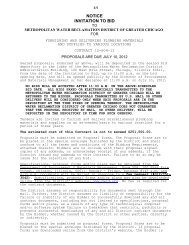Report - Metropolitan Water Reclamation District of Greater Chicago
Report - Metropolitan Water Reclamation District of Greater Chicago
Report - Metropolitan Water Reclamation District of Greater Chicago
You also want an ePaper? Increase the reach of your titles
YUMPU automatically turns print PDFs into web optimized ePapers that Google loves.
In June 2001, the Radiochemistry Laboratory was certified by the Illinois Emergency<br />
Management Agency (IEMA), Division <strong>of</strong> Nuc1ear Safety for the radiochemical analysis <strong>of</strong> potable<br />
water.<br />
The certification programs administered by the IDPH and the IEMA follow guidelines<br />
contained in the United States Environmental Protection Agency (USEP A) Manual for the<br />
Certification <strong>of</strong> Laboratories Analyzing Drinking <strong>Water</strong>. These guidelines are compliant with<br />
regulations issued pursuant to the Safe Drinking <strong>Water</strong> Act. Currently, no fees are charged for<br />
certifications <strong>of</strong> the Analytical Microbiology Laboratory and the Radiochemistry Laboratory.<br />
Use Attainability Analysis Study<br />
The IEPA began the <strong>Chicago</strong> Area <strong>Water</strong>way System (CAWS) Use Attainability Analysis<br />
(UAA) Study in 2002 to determine if these waterways can support a higher use designation<br />
and meet the goals <strong>of</strong> the Clean <strong>Water</strong> Act. Most <strong>of</strong> these waterways are designated as Secondary<br />
Contact and Indigenous Aquatic Life Use and an examination <strong>of</strong> this use designation has<br />
been urged for several years by the USEP A. The <strong>District</strong> is committed in its National Pollutant<br />
Discharge Elimination System (NPDES) permits to participate in and support the UAA Study.<br />
The <strong>District</strong> is carrying out this commitment by making available all <strong>of</strong> the water quality and related<br />
data from its monitoring activities and has developed an unsteady-state hydraulic and water<br />
quality model <strong>of</strong> the waterway system. This model has proven useful in determining water quality<br />
impacts associated with water quality improvement scenarios proposed as part <strong>of</strong> the UAA.<br />
Since the IEP A submitted its UAA proposal to the Illinois Pollution Control Board (IPCB),<br />
(Docket Number R08-9) in October 2007, the <strong>District</strong> has been actively participating at the hearings<br />
and has provided technical support through review <strong>of</strong> study reports, the conduct <strong>of</strong> a quantitative<br />
microbial risk assessment for recreational use <strong>of</strong> the waterways, a review <strong>of</strong> the regulatory<br />
criteria for bacterial standards, and provision <strong>of</strong> ambient water quality monitoring data. In<br />
2010 the <strong>District</strong>, through the University <strong>of</strong> Illinois, completed the three year epidemiological<br />
study <strong>of</strong> secondary contact use <strong>of</strong> the waterways, and also completed a waterways habitat evaluation<br />
and improvement study, and filed the results <strong>of</strong> each with the IPCB in R08-9. Extensive<br />
testimony was also provided on the results <strong>of</strong> the epidemiological study and its implications regarding<br />
IEPA's proposed effluent limitations for fecal coliform bacteria.<br />
Departmental <strong>Report</strong>s<br />
During 2010, the Department published 62 formal reports dealing with various aspects <strong>of</strong><br />
the <strong>District</strong>'s operations. A list <strong>of</strong> these reports is given in Table 1.<br />
4
















